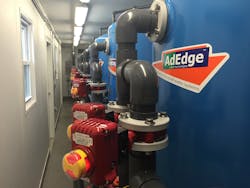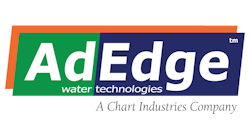The city of Warm Springs is a small community of approximately 1,000 residents located in central Georgia. In 2010, water testing found a radium level between 8 to 11 pCi/L and a gross alpha level of 25 pCi/L, both above state and federal drinking water regulations of 5 pCi/L and 15 pCi/L respectively.
Engineering Management Inc. (EMI) conducted a pilot test in late 2010 to test a manganese dioxide coated media for the removal of the radium and gross alpha particle material from the water. After successful piloting of the treatment approach and through an award process, EMI contracted AdEdge Water Technologies to design, manufacture and install a radium and gross alpha particle removal system for the city of Warm Springs. The AdEdge WaterPOD delivery option was chosen given cost and schedule advantages over traditional building approaches.
The AdEdge radium and gross alpha treatment solution consists of a co-precipitation process within a WaterPOD containerized system rated for 250 gal per minute. The model APU26-4860CS-6-AVH utilizes AdEdge ADGS+ media in a six-vessel carbon steel configuration in parallel. The treatment system is pre-packaged within a housed 40-ft modularized structure equipped with HVAC, pedestrian doors, ventilation windows and lighting. The WaterPOD system sits on a concrete foundation. The vessels are loaded with AdEdge’s ADGS+ filtration media for the removal of radium and gross alpha. The media is NSF 61 certified for use in drinking water.
The raw water from the well(s) is injected with sodium hypochlorite and a manganese salt prior to being treated in the treatment vessels for optimal radium co-precipitation and removal. Chemical feed dosing is pulse-controlled by the treatment system’s programmable logic controller (PLC). The feed rate is adjusted based on system flow rates. The PLC performs all automated functions needed for proper operation of the control valves.
Backwashing of the treatment vessels occurs two to three times a week depending on the incoming radium and gross alpha levels and volume of treated water to remove particulates and to prevent hydraulic channeling. Backwash water is disposed of in a sanitary sewer. The WaterPOD delivery offers cost advantages over traditional buildings and is the first Georgia installation of this type.
The treatment system was installed and commissioned in October 2014. Since the treatment system began operation, the radium and gross alpha levels have been reduced to non-detectable levels.
Richard J. Cavagnaro is marketing coordinator for AdEdge. Cavagnaro can be reached at [email protected] or 678.835.0052.


